IKEA's Expansion: Case Analysis of Cultural Adaptation and Innovation
VerifiedAdded on 2023/06/04
|10
|894
|215
Case Study
AI Summary
This case analysis delves into the challenges faced by IKEA, a global brand, due to its lack of understanding of diverse cultures and its reliance on a standardization model. The primary problem identified is the difficulty customers face in adapting to Scandinavian styles, alongside issues such as delayed deliveries due to metric system misunderstandings, lack of innovation, and intense competition. The analysis applies Motivation Need Theory and Glocalization Theory to propose recommendations such as customization to local needs, local recruitment, establishing an international cultural team to foster diversity, and product differentiation to enhance competitiveness. The conclusion emphasizes that adopting these strategies will lead to increased customer satisfaction, a positive brand image, and improved profitability. Desklib offers a platform to explore similar solved assignments and past papers for students.

IKEA: SCANDINAVIAN
STYLE
Case Analysis
STYLE
Case Analysis
Paraphrase This Document
Need a fresh take? Get an instant paraphrase of this document with our AI Paraphraser

SITUATION ANALYSIS
IKEA Scandinavian case offers a
background on IKEA.
The organization was found in 1943 by
Ingvar Kamprad at the age of 17.
IKEA is well known for its flat box
storage of furniture.
IKEA offers excellent quality furniture at
low costs through operational efficiency.
IKEA is a global brand and has broken
geographical boundaries and spread its
business to different parts of the world
IKEA Scandinavian case offers a
background on IKEA.
The organization was found in 1943 by
Ingvar Kamprad at the age of 17.
IKEA is well known for its flat box
storage of furniture.
IKEA offers excellent quality furniture at
low costs through operational efficiency.
IKEA is a global brand and has broken
geographical boundaries and spread its
business to different parts of the world
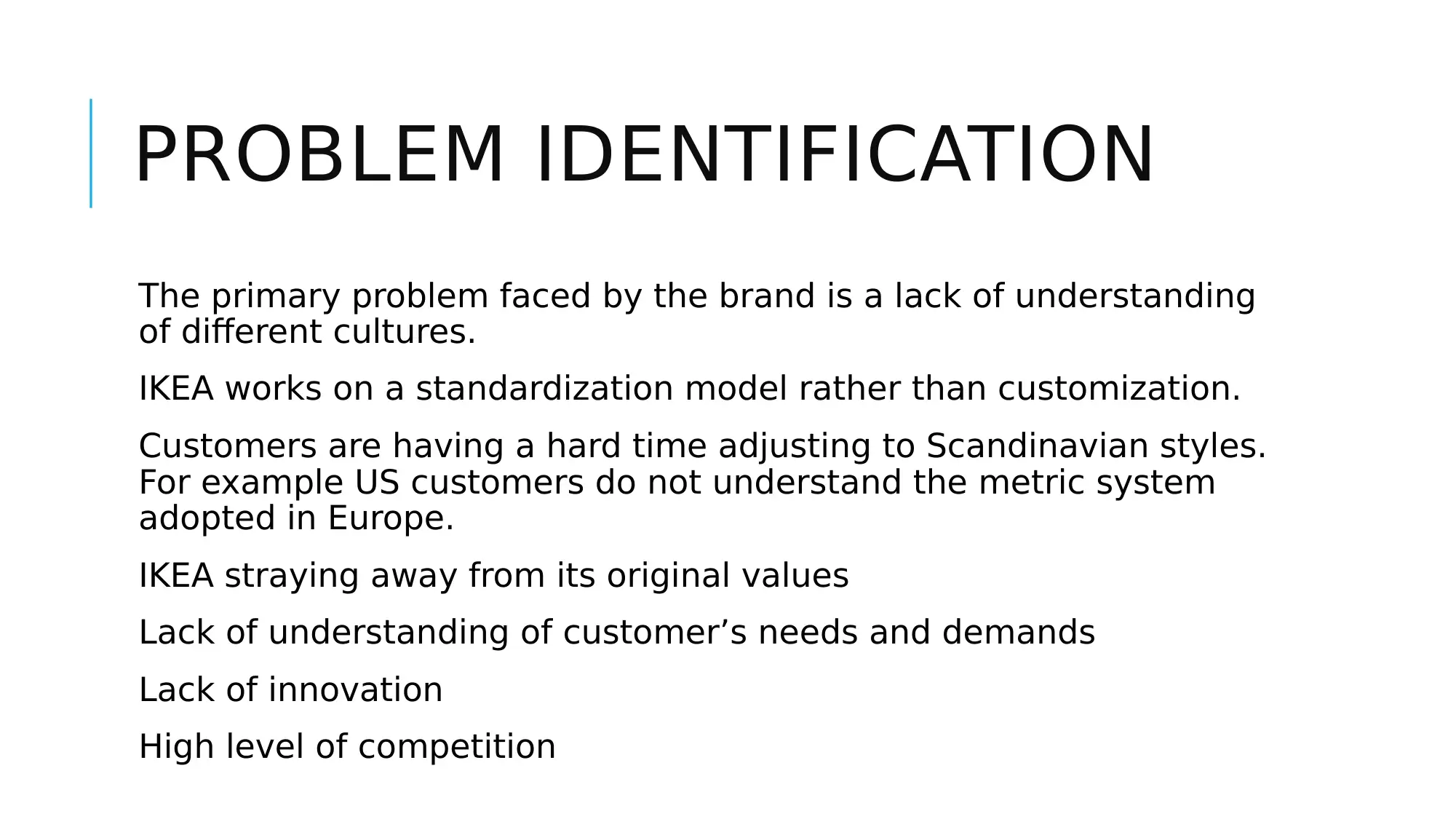
PROBLEM IDENTIFICATION
The primary problem faced by the brand is a lack of understanding
of different cultures.
IKEA works on a standardization model rather than customization.
Customers are having a hard time adjusting to Scandinavian styles.
For example US customers do not understand the metric system
adopted in Europe.
IKEA straying away from its original values
Lack of understanding of customer’s needs and demands
Lack of innovation
High level of competition
The primary problem faced by the brand is a lack of understanding
of different cultures.
IKEA works on a standardization model rather than customization.
Customers are having a hard time adjusting to Scandinavian styles.
For example US customers do not understand the metric system
adopted in Europe.
IKEA straying away from its original values
Lack of understanding of customer’s needs and demands
Lack of innovation
High level of competition
⊘ This is a preview!⊘
Do you want full access?
Subscribe today to unlock all pages.

Trusted by 1+ million students worldwide
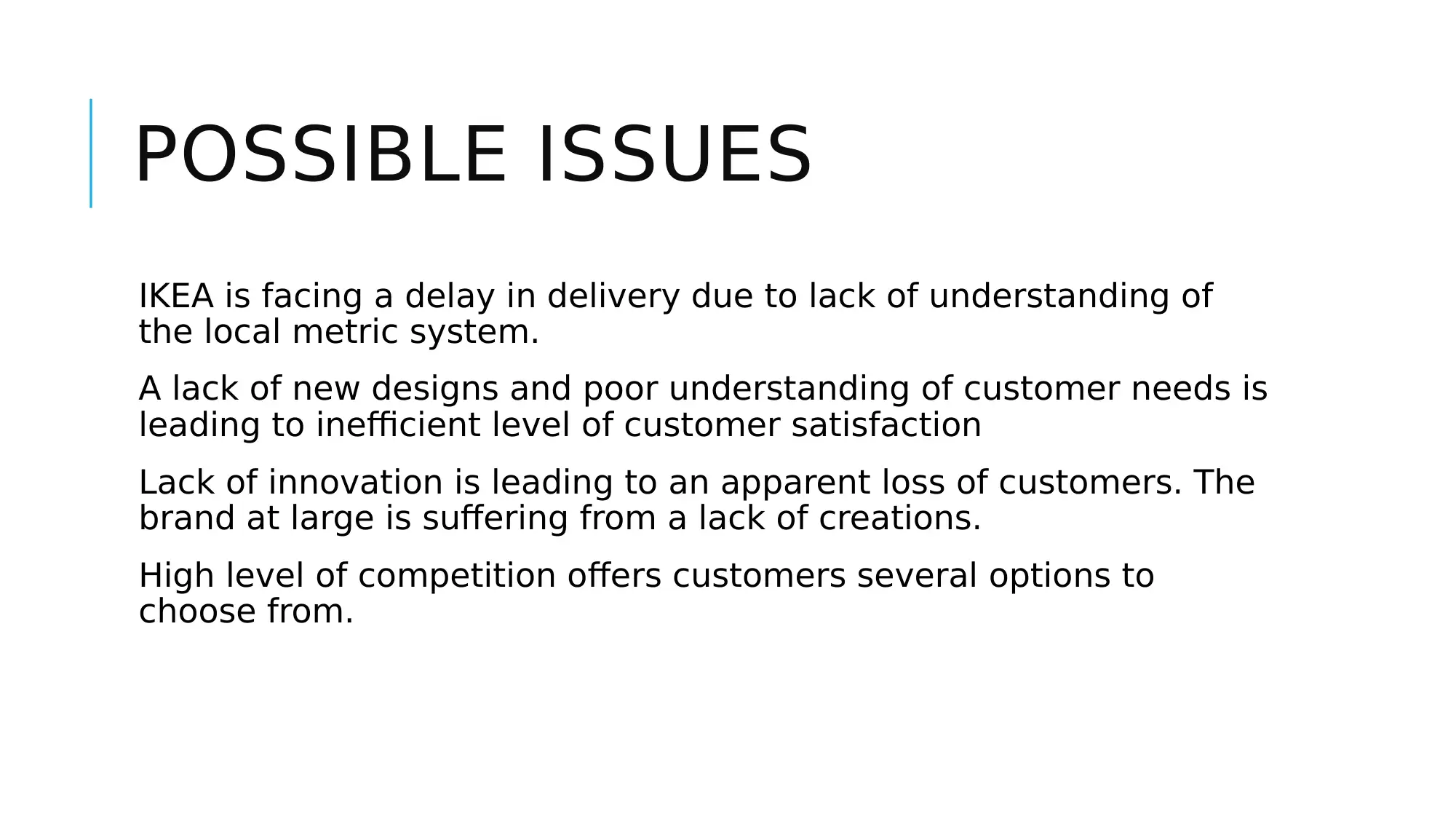
POSSIBLE ISSUES
IKEA is facing a delay in delivery due to lack of understanding of
the local metric system.
A lack of new designs and poor understanding of customer needs is
leading to inefficient level of customer satisfaction
Lack of innovation is leading to an apparent loss of customers. The
brand at large is suffering from a lack of creations.
High level of competition offers customers several options to
choose from.
IKEA is facing a delay in delivery due to lack of understanding of
the local metric system.
A lack of new designs and poor understanding of customer needs is
leading to inefficient level of customer satisfaction
Lack of innovation is leading to an apparent loss of customers. The
brand at large is suffering from a lack of creations.
High level of competition offers customers several options to
choose from.
Paraphrase This Document
Need a fresh take? Get an instant paraphrase of this document with our AI Paraphraser
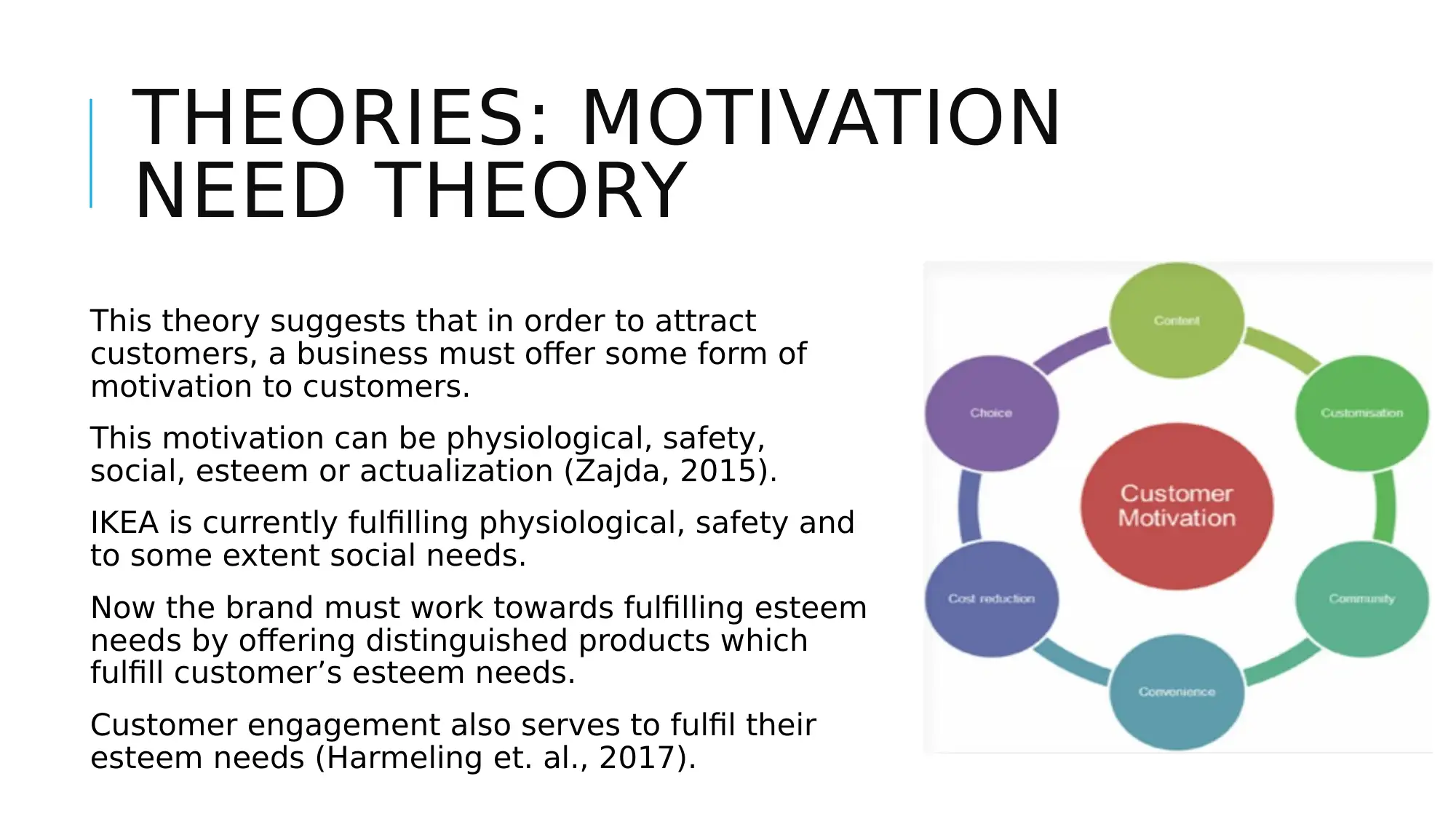
THEORIES: MOTIVATION
NEED THEORY
This theory suggests that in order to attract
customers, a business must offer some form of
motivation to customers.
This motivation can be physiological, safety,
social, esteem or actualization (Zajda, 2015).
IKEA is currently fulfilling physiological, safety and
to some extent social needs.
Now the brand must work towards fulfilling esteem
needs by offering distinguished products which
fulfill customer’s esteem needs.
Customer engagement also serves to fulfil their
esteem needs (Harmeling et. al., 2017).
NEED THEORY
This theory suggests that in order to attract
customers, a business must offer some form of
motivation to customers.
This motivation can be physiological, safety,
social, esteem or actualization (Zajda, 2015).
IKEA is currently fulfilling physiological, safety and
to some extent social needs.
Now the brand must work towards fulfilling esteem
needs by offering distinguished products which
fulfill customer’s esteem needs.
Customer engagement also serves to fulfil their
esteem needs (Harmeling et. al., 2017).
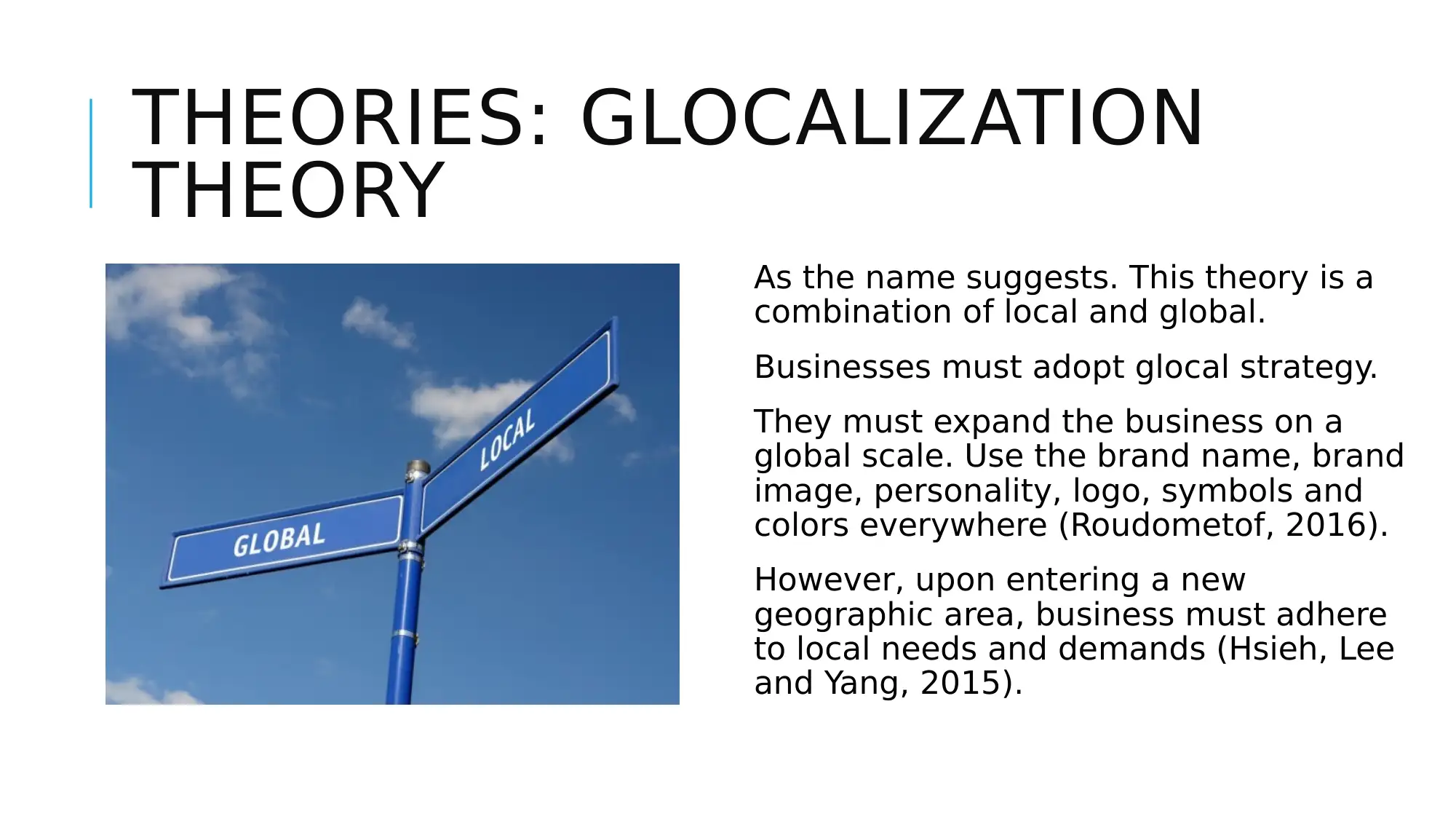
THEORIES: GLOCALIZATION
THEORY As the name suggests. This theory is a
combination of local and global.
Businesses must adopt glocal strategy.
They must expand the business on a
global scale. Use the brand name, brand
image, personality, logo, symbols and
colors everywhere (Roudometof, 2016).
However, upon entering a new
geographic area, business must adhere
to local needs and demands (Hsieh, Lee
and Yang, 2015).
THEORY As the name suggests. This theory is a
combination of local and global.
Businesses must adopt glocal strategy.
They must expand the business on a
global scale. Use the brand name, brand
image, personality, logo, symbols and
colors everywhere (Roudometof, 2016).
However, upon entering a new
geographic area, business must adhere
to local needs and demands (Hsieh, Lee
and Yang, 2015).
⊘ This is a preview!⊘
Do you want full access?
Subscribe today to unlock all pages.

Trusted by 1+ million students worldwide
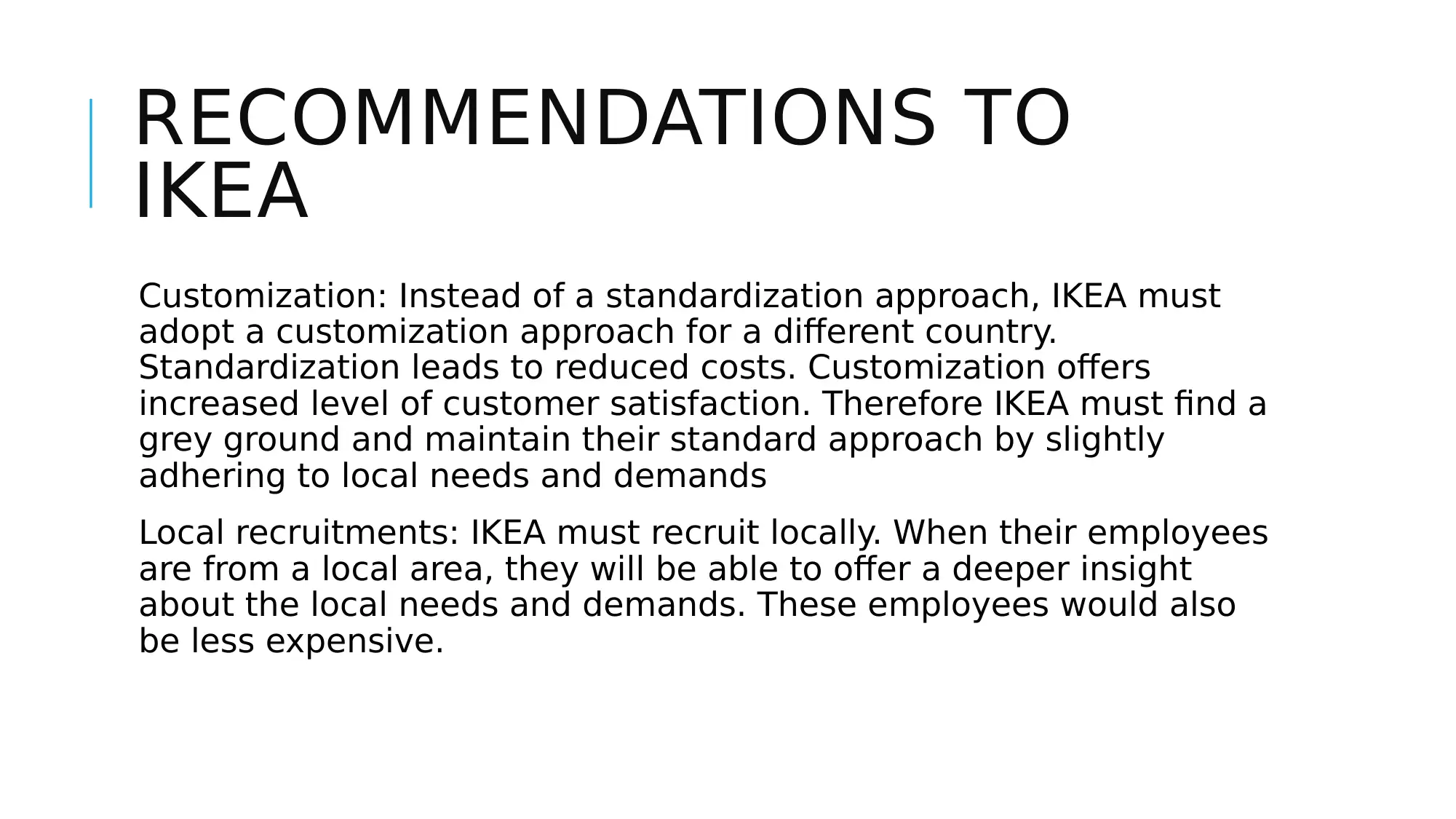
RECOMMENDATIONS TO
IKEA
Customization: Instead of a standardization approach, IKEA must
adopt a customization approach for a different country.
Standardization leads to reduced costs. Customization offers
increased level of customer satisfaction. Therefore IKEA must find a
grey ground and maintain their standard approach by slightly
adhering to local needs and demands
Local recruitments: IKEA must recruit locally. When their employees
are from a local area, they will be able to offer a deeper insight
about the local needs and demands. These employees would also
be less expensive.
IKEA
Customization: Instead of a standardization approach, IKEA must
adopt a customization approach for a different country.
Standardization leads to reduced costs. Customization offers
increased level of customer satisfaction. Therefore IKEA must find a
grey ground and maintain their standard approach by slightly
adhering to local needs and demands
Local recruitments: IKEA must recruit locally. When their employees
are from a local area, they will be able to offer a deeper insight
about the local needs and demands. These employees would also
be less expensive.
Paraphrase This Document
Need a fresh take? Get an instant paraphrase of this document with our AI Paraphraser
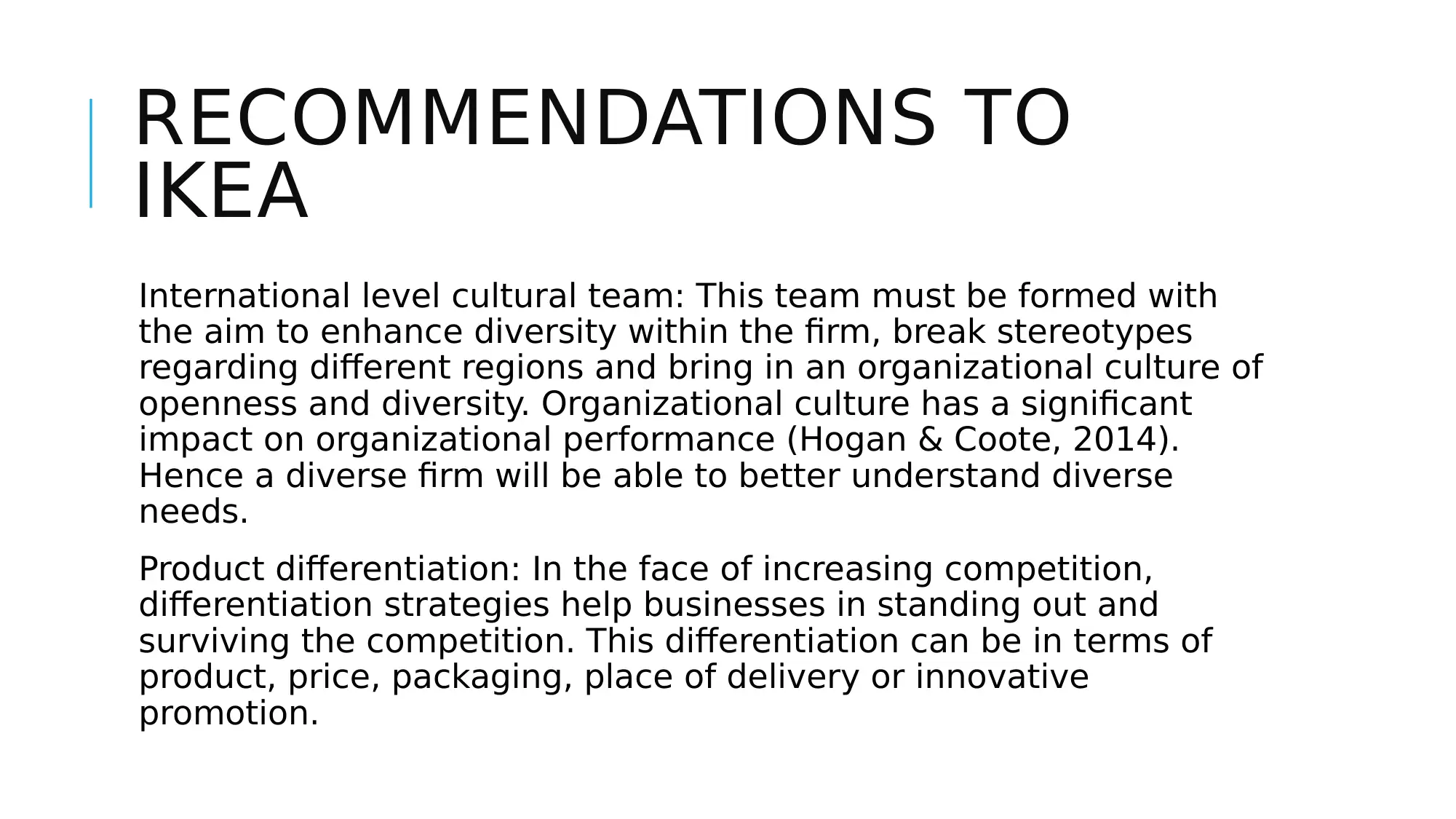
RECOMMENDATIONS TO
IKEA
International level cultural team: This team must be formed with
the aim to enhance diversity within the firm, break stereotypes
regarding different regions and bring in an organizational culture of
openness and diversity. Organizational culture has a significant
impact on organizational performance (Hogan & Coote, 2014).
Hence a diverse firm will be able to better understand diverse
needs.
Product differentiation: In the face of increasing competition,
differentiation strategies help businesses in standing out and
surviving the competition. This differentiation can be in terms of
product, price, packaging, place of delivery or innovative
promotion.
IKEA
International level cultural team: This team must be formed with
the aim to enhance diversity within the firm, break stereotypes
regarding different regions and bring in an organizational culture of
openness and diversity. Organizational culture has a significant
impact on organizational performance (Hogan & Coote, 2014).
Hence a diverse firm will be able to better understand diverse
needs.
Product differentiation: In the face of increasing competition,
differentiation strategies help businesses in standing out and
surviving the competition. This differentiation can be in terms of
product, price, packaging, place of delivery or innovative
promotion.
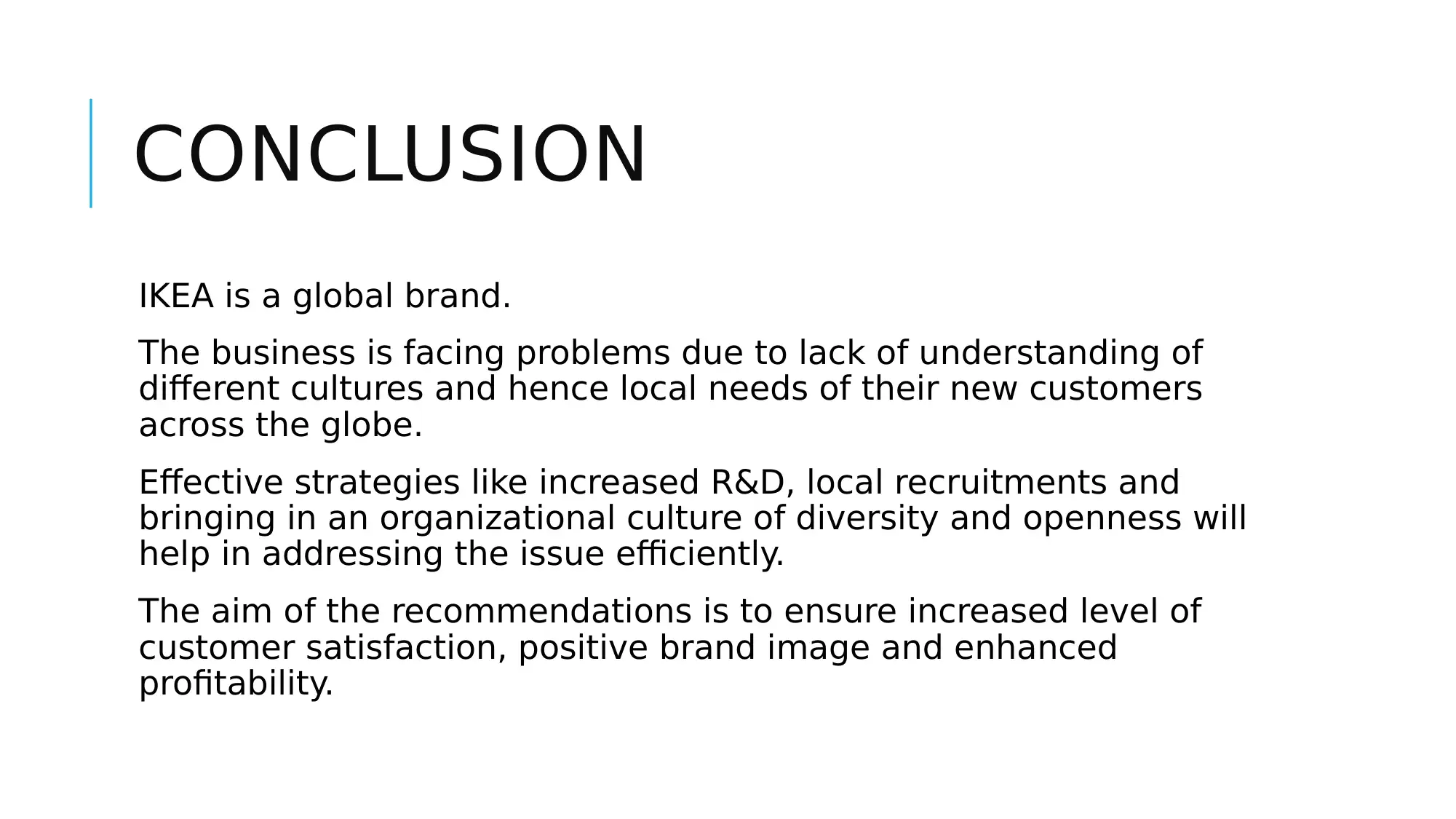
CONCLUSION
IKEA is a global brand.
The business is facing problems due to lack of understanding of
different cultures and hence local needs of their new customers
across the globe.
Effective strategies like increased R&D, local recruitments and
bringing in an organizational culture of diversity and openness will
help in addressing the issue efficiently.
The aim of the recommendations is to ensure increased level of
customer satisfaction, positive brand image and enhanced
profitability.
IKEA is a global brand.
The business is facing problems due to lack of understanding of
different cultures and hence local needs of their new customers
across the globe.
Effective strategies like increased R&D, local recruitments and
bringing in an organizational culture of diversity and openness will
help in addressing the issue efficiently.
The aim of the recommendations is to ensure increased level of
customer satisfaction, positive brand image and enhanced
profitability.
⊘ This is a preview!⊘
Do you want full access?
Subscribe today to unlock all pages.

Trusted by 1+ million students worldwide
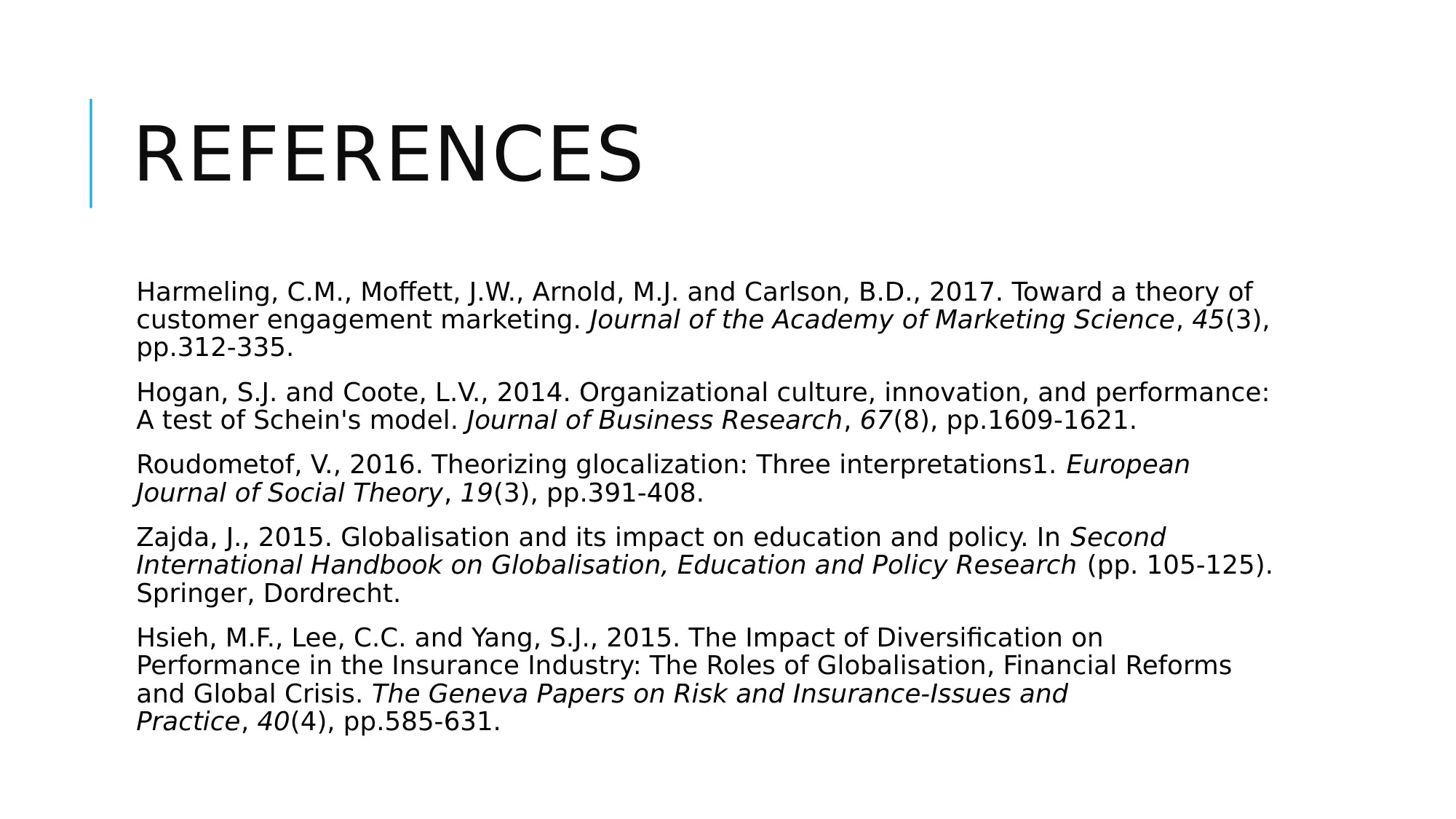
REFERENCES
Harmeling, C.M., Moffett, J.W., Arnold, M.J. and Carlson, B.D., 2017. Toward a theory of
customer engagement marketing. Journal of the Academy of Marketing Science, 45(3),
pp.312-335.
Hogan, S.J. and Coote, L.V., 2014. Organizational culture, innovation, and performance:
A test of Schein's model. Journal of Business Research, 67(8), pp.1609-1621.
Roudometof, V., 2016. Theorizing glocalization: Three interpretations1. European
Journal of Social Theory, 19(3), pp.391-408.
Zajda, J., 2015. Globalisation and its impact on education and policy. In Second
International Handbook on Globalisation, Education and Policy Research (pp. 105-125).
Springer, Dordrecht.
Hsieh, M.F., Lee, C.C. and Yang, S.J., 2015. The Impact of Diversification on
Performance in the Insurance Industry: The Roles of Globalisation, Financial Reforms
and Global Crisis. The Geneva Papers on Risk and Insurance-Issues and
Practice, 40(4), pp.585-631.
Harmeling, C.M., Moffett, J.W., Arnold, M.J. and Carlson, B.D., 2017. Toward a theory of
customer engagement marketing. Journal of the Academy of Marketing Science, 45(3),
pp.312-335.
Hogan, S.J. and Coote, L.V., 2014. Organizational culture, innovation, and performance:
A test of Schein's model. Journal of Business Research, 67(8), pp.1609-1621.
Roudometof, V., 2016. Theorizing glocalization: Three interpretations1. European
Journal of Social Theory, 19(3), pp.391-408.
Zajda, J., 2015. Globalisation and its impact on education and policy. In Second
International Handbook on Globalisation, Education and Policy Research (pp. 105-125).
Springer, Dordrecht.
Hsieh, M.F., Lee, C.C. and Yang, S.J., 2015. The Impact of Diversification on
Performance in the Insurance Industry: The Roles of Globalisation, Financial Reforms
and Global Crisis. The Geneva Papers on Risk and Insurance-Issues and
Practice, 40(4), pp.585-631.
1 out of 10
Related Documents
Your All-in-One AI-Powered Toolkit for Academic Success.
+13062052269
info@desklib.com
Available 24*7 on WhatsApp / Email
![[object Object]](/_next/static/media/star-bottom.7253800d.svg)
Unlock your academic potential
Copyright © 2020–2025 A2Z Services. All Rights Reserved. Developed and managed by ZUCOL.




